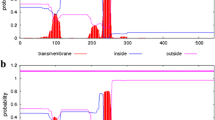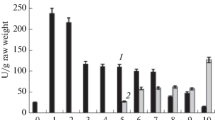Abstract
Three plastidic chorismate synthase isozymes (CS1, CS2 and CS2Δ) of tomato were identified by isolation of the corresponding cDNAs. These three cDNAs are derived from only two genes (LeCS1 and LeCS2). This additional complexity results from differential splicing of the primary transcript of one of the genes (LeCS2) giving rise to two different transcripts (CS2 and CS2Δ transcripts). All three isozymes were individually expressed in Escherichia coli both as precursor proteins with N-terminal transit peptides and as mature proteins. Only the mature but not the precursor isozymes CS1 and CS2 were enzymatically active. The enzyme CS2Δ was unstable in E. coli. Both CS1 and CS2 were purified to near homogeneity and their enzymatic properties were analyzed. They differ substantially in their K m values for the substrate 5-enol-pyruvylshikimate 3-phosphate (11 and 80 μM for the mature forms of CS1 and CS2, respectively). The two isozymes appear to be active only as oligomers, and the potential physiological implications of this result are discussed.
Similar content being viewed by others
Abbreviations
- CS:
-
chorismate synthase
- CS1, CS2, CS2Δ:
-
tomato chorismate synthase isozymes
- DMS:
-
[dimethylsuberimidate
- EPSP:
-
5-enolpyruvylshikimate 3-phosphate
- IPTG:
-
isopropylβ-d-thiogalactopyranoside
- LeCS1, LeCS2 :
-
tomato chorismate synthase genes
References
Amann E, Ochs B, Abel K-J (1988) Tightly regulated tac promoter vectors useful for expression of unfused and fused proteins in Escherichia coli. Gene 69: 301–315
Appert C, Logemann E, Hahlbrock K, Schmid J, Amrhein N (1994) Structural and catalytic properties of the four phenylalanine ammonia-lyase isoenzymes from parsley (Petroselinum itcrispum Nym). Eur J Biochem 225: 491–499
Ausubel FM, Brent R, Kingston RE, Moore DD, Seidman JG, Smith JA, Struhl K (1987) Current protocols in molecular biology. Greene Publishing Associates and Wiley-Interscience, New York
Bornemann S, Ramjee MK, Balasubramanian S, Abell C, Coggins JR, Lowe DJ, Thorneley RNF (1995) Escherichia coli chorismate synthase catalyzes the conversion of (6S)-6-fluoro-5-enolpyruvylshikimate-3-phosphate to 6-fluorochorismate. J Biol Chem 270: 22811–22815
Bradford MM (1976) A rapid and sensitive method for the quantification of microgram quantities of protein utilizing the principle of protein-dye binding. Anal Biochem 72: 248–254
Gärtner FH, Cole KW (1973) Properties of chorismate synthase in Neurospora crassa. J Biol Chem 248: 4602–4609
Gavel Y, von Heijne G (1990) A conserved cleavage-site motif in chloroplast transit peptides. FEES Lett 261: 455–458
Görlach J, Schmid J, Amrhein N (1993) Differential expression of tomato (Lycopersicon esculentum L.) genes encoding shikimate pathway isoenzymes. II. Chorismate synthase. Plant Mol Biol 23: 707–716
Görlach J, Schmid J, Amrhein N (1994) Abundance of transcripts specific for genes encoding enzymes of the prechorismate pathway in different organs of tomato (Lycopersicon esculentum L.) plants. Planta 193: 216–223
Görlach J, Raesecke H-R, Abel G, Wehrli R, Amrhein N, Schmid J (1995a) Organ-specific differences in the ratio of alternatively spliced chorismate synthase (LeCS2) transcripts in tomato. Plant J 8: 451–456
Görlach J, Raesecke H-R, Rentsch D, Regenass M, Roy P, Zala M, Keel C, Boiler T, Amrhein N, Schmid J (1995b) Temporally distinct accumulation of transcripts encoding enzymes of the prechorismate pathway in elicitor-treated cultured tomato cells. Proc Natl Acad Sci USA 92: 3166–3170
Henstrand JM, Amrhein N, Schmid J (1995a) Cloning and characterization of a heterologously expressed bifunctional chorismate synthase/flavin reductase from Neurospora crassa. J Biol Chem 270: 20447–20452
Henstrand JM, Schmid J, Amrhein N (1995b) Only the mature form of the plastidic chorismate synthase is enzymatically active. Plant Physiol 108: 1127–1132
Keegstra K, Olsen LJ, Theg SM (1989) Chloroplastic precursors and their transport across the envelope membranes. Annu Rev Plant Physiol Plant Mol Biol 40: 471–501
Laemmli UK (1970) Cleavage of structural proteins during the assembly of the head of bacteriophage T4. Nature 227: 680–685
Logemann E, Parniske M, Hahlbrock K (1995) Modes of expression and common structural features of the complete phenylalanine ammonia-lyase gene family in parsley. Proc Natl Acad Sci USA 92: 5905–5909
Lumsden J, Coggins JR (1977) The subunit structure of the arom multienzyme complex of Neurospora crassa. A possible pentafunctional polypeptide chain. Biochem J 161: 599–607
Millar G, Anton IA, Mousdale DM, White PJ, Coggins JR (1986) Cloning and overexpression of the Escherichia coli aroC gene encoding the enzyme chorismate synthase. Biochem Soc Trans 14: 262–263
Mousdale DM, Coggins JR (1986) Detection and subcellular localization of a higher plant chorismate synthase. FEBS Lett 205: 328–332
Pittard J, Wallace BJ (1966) Distribution and function of genes concerned with aromatic biosynthesis in Escherichia coli. J Bacteriol 91: 1494–1508
Ramjee MK, Coggins JR, Hawkes TR, Lowe DJ, Thorneley RNF (1993) The stoichiometry of binding of flavin mononucleotide (FMN) hydroquinone to Escherichia coli chorismate synthase. Bioorg Med Chem Lett 3: 1409–1414
Ramjee MK, Coggins JR, Thorneley RNF (1994) A continuous, anaerobic spectrophotometric assay for chorismate synthase activity utilizes photoreduced flavin mononucleotide. Anal Biochem 220: 137–141
Sambrook J, Fritsch EF, Maniatis T (1989) Molecular cloning: A laboratory manual. Cold Spring Harbor Laboratory Press, New York
Schaller A, Windhofer V, Amrhein N (1990) Purification of chorismate synthase from a cell culture of the higher plant Corydalis sempervirens Pers. Arch Biochem Biophys 282: 437–442
Schaller A, Schmid J, Leibinger U, Amrhein N (1991) Molecular cloning and analysis of a cDNA coding for chorismate synthase from the higher plant Corydalis sempervirens Pers. J Biol Chem 266: 21434–21438
Walsh CT, Liu J, Rusnak F, Sakaitani M (1990) Molecular studies n enzymes in chorismate metabolism and the enterobactin biosynthetic pathway. Chem Rev 90: 1105–1129
White PJ, Millar G, Coggins JR (1988) The overexpression, purification and complete amino acid sequence of chorismate synthase from Escherichia coli K12 and its comparison with the enzyme from Neurospora crassa. Biochem J 251: 313–322
Author information
Authors and Affiliations
Additional information
Dedicated to Professor Andreas Sievers, Bonn, on the occasion of his 65th birthday
We thank Drs. J.R. Coggins (Department of Biochemistry, University of Glasgow, UK) for the E. coli strain AB2849, the plasmid pGM602 and his help in establishing the continuous CS assay, W. Staudenmann (ETH-Ziirich, Switzerland) for the determination of the N-terminal sequences and the determination of the molecular mass of MatCSl, P. Pfister (ETH-Zurich) for his help with the fermentor, D. Rubli (ETH-Zurich) for preparing the photographs, and A. Schaller (ETH-Ziirich) for critically reading the manuscript. This work was supported by grants from the Swiss National Science Foundation (to J.S. and N.A.).
Rights and permissions
About this article
Cite this article
Braun, M., Henstrand, J.M., Görlach, J. et al. Enzymatic properties of chorismate synthase isozymes of tomato (Lycopersicon esculentum Mill.). Planta 200, 64–70 (1996). https://doi.org/10.1007/BF00196650
Received:
Accepted:
Issue Date:
DOI: https://doi.org/10.1007/BF00196650




